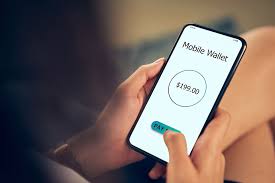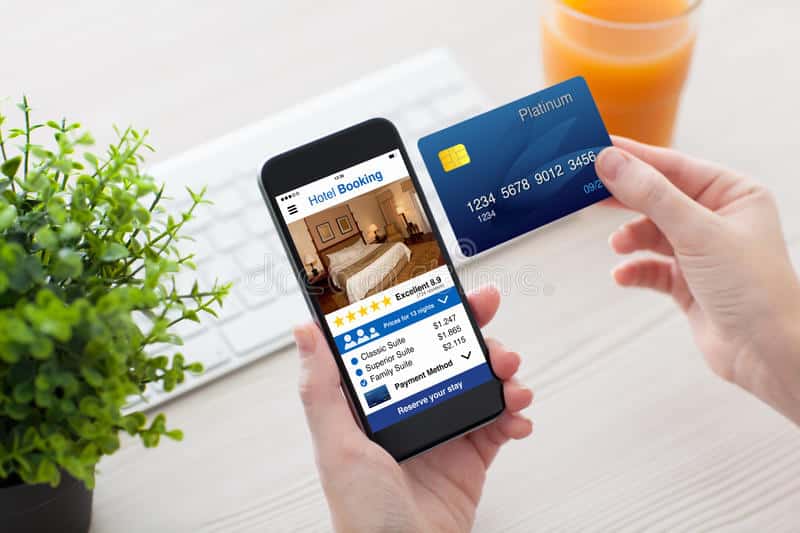Nowadays, we can only imagine daily life with our smartphones, smartwatches, laptops, and tablets. You can quickly and easily complete various routine chores with a few taps or clicks. This includes being able to make purchases without actually having your credit card with you. If you want to learn more about the best EBT mobile wallet app and crypto, you’ve come to the right place.
What Is a Mobile Wallet?
A mobile wallet is a virtual wallet with a credit card, debit card, and loyalty card information. A mobile wallet is accessed via an app on a mobile device, such as a smartphone or tablet.
In-store mobile wallet payments offer customers a handy alternative to cash and traditional credit card transactions. Shops registered with mobile network operators as accepting mobile wallets are the only ones at which you can use them to make purchases.
Google Pay, Apple Pay, and Samsung Pay are the top three mobile wallet apps currently in use. Users can either have the wallets pre-installed on their mobile devices or download the wallet app from an online shop.
Grasping the Concept of a Mobile Wallet
Increasingly, interactions between companies and customers are happening online. Companies are adapting their methods, from e-commerce sites to robo-advisors, in order to keep up with customers’ ever-shifting expectations and the proliferation of mobile technology.
The term “fintech” has come to describe a new breed of companies that provide financial services and products only through digital channels. These firms produce revolutionary yet inexpensive resources that anyone may use. Currently, the payments sector, in particular, is seeing significant development. Businesses and consumers alike are adjusting to the widespread usage of mobile wallets and similar devices for both online and offline purchases.
Smartphones either come equipped with a mobile wallet functionality or offer the option to download a dedicated app. A mobile wallet can link to your bank account and hold your credit, debit, coupon, and reward cards. After the user downloads the app and enters their payment information, the mobile wallet maintains this data by associating a unique identifier (such as a number, key, QR code, fingerprint, or face recognition) with each card.
Furthermore, Near-field communication (NFC) is a technique that uses radio frequencies to communicate between devices, and this is what the mobile app does when the user makes a payment to the retailer.
NFC uses the user’s personal identification format to send the user’s payment information to the store’s POS terminal. Using near-field communication (NFC) technology, customers can start data transmission by waving or holding their mobile device over an NFC scanner in a business.
What Are the 3 Types of Mobile Wallets?
Mobile wallet systems can be broken down into the following types:
#1. Semi-closed Wallets
Semi-closed mobile wallets enable users to use the funds in the wallet to make payments for transactions with multiple merchants so long as there is an existing contract between the merchant and the company that operates the mobile wallet. Open mobile wallets do not allow users to use the funds in the wallet to make payments for transactions with multiple merchants. Customers also have the option of withdrawing the funds into a bank account of their choosing. But, users with semi-closed wallets are not permitted to withdraw currency from their accounts.
#2. Open Wallets
In an open wallet, a bank or third party can access the funds at any time. Customers with an open wallet can use their mobile wallet funds to pay for purchases or withdraw cash at any time. PayPal is a popular open mobile wallet that enables users to make in-store and online transactions as well as withdraw monies to their bank account.
#3. Closed Wallets
To prevent their funds from being used for any other purpose, users of closed wallets can only use them to pay for purchases made at the associated store. Withdrawing cash from ATMs or using the balance to pay for goods or services at any other business is strictly wrong. Amazon Pay is a closed wallet service.
How Do I Open a Wallet Account?
Here are a few steps to open a wallet account:
- Get the mobile wallet app now.
- Put in the pertinent details.
- Get yourself a password or PIN.
- Sync your credit and debit cards.
- Provide monetary compensation.
Mobile Wallet App
In this malware, health-conscious future that we’ve invented, cashless and contactless interactions have witnessed a tremendous uptick. The rapidly developing realm of mobile payment systems is to thank for these hands-free options. Nowadays, it’s not unusual for a purchase to be completed entirely online, eliminating the need to fish around in your mobile wallet for potentially dirty money and credit cards. Considering how often we use them, it makes sense to make purchases with our phones (or lend a buddy cash or buy yourself lunch). Furthermore, you may not even have to download a mobile wallet app when using these services. Here are some of the mobile wallet apps:
#1. Google Pay
Google Pay is the company’s all-in-one solution for buying things in stores, on the web, and between friends. Instead of having to switch between Google Pay Send and Android Pay whenever you want to pay someone by NFC, you can just use this one app. The software is compatible with iOS, Android, and the web, giving it a wider reach than rivals like Apple Pay and Samsung Pay. Google Pay, like Apple Pay and Samsung Pay, is a mobile payment system that uses near-field communication and is compatible with a number of devices.
However, not unlike Venmo, PayPal, Square Cash, or Zelle. Do you mind giving Google access to yet another facet of your life? is the only question you need to ask. If you answered no, then this user-friendly payment software is exactly what you need. To put it simply, it’s the best mobile wallet app available, according to reviewers.
During the past few years, Google’s approach to payment apps has been somewhat elusive. Before Apple Pay, there was Google Wallet, which offered the same contactless payment convenience. After that, support for Android Pay took its place.
#2. Cash App
As the manufacturer of the ubiquitous white credit card readers, Square is a household name. Despite the company’s recent rebranding to Block, Inc., the quality and breadth of Square’s digital services and other offerings have only increased. The company’s free mobile wallet tool, allows you to send and receive money with friends, make contactless payments with Square readers, and shop online using the Cash App debit card. It has stiff competition from the likes of Apple Pay, Google Pay, Venmo, PayPal, and Zelle in the mobile payment app market. Nonetheless, the app still stands out due to its many useful features, such as its ability to file taxes and buy stocks and Bitcoin.
#3. Paypal
Although PayPal is most commonly associated with online purchases, its mobile wallet app can also be used to send money to friends. The mobile apps for both Venmo and PayPal, which owns the younger service, are nearly identical. While Apple Pay and Google Wallet are still the go-to methods for making in-store purchases, the PayPal mobile wallet app allows you to make and request in-app payments with friends (even if they don’t have the app), on websites, and in some brick-and-mortar establishments. An important limitation of using the coronavirus for in-person payments is that it does not support NFC payments, unlike the OS platform.
When comparing PayPal’s current app to Venmo, which tries to take advantage of millennials’ tendency to share too much, some users may like PayPal’s simpler approach. It also benefits from the fact that almost everyone who shops online already has a PayPal account and that an enormous number of online stores accept PayPal. Also, the corporation is beginning to promote the app as a means of making purchases in physical stores.
#4. Zelle
Zelle, a mobile wallet app, may have less recognition than Venmo, but it is certainly not a minor player. Its backing banking consortium claims to have processed over $133 billion in over 519 million transactions in the first half of 2020. When compared to other mobile payment services, Zelle stands out because it is typically integrated into your bank’s app or website. In contrast to services like Apple Pay, Google Pay, and Square Cash, payments are deposited directly into the recipient’s bank account.
While this is convenient, the service does share your data with marketers and does not allow for in-store transactions, so keep that in mind. If you’re looking to make quick, simple, and free money transfers to people you already know, then Zelle is the way to go.
#5. Venmo
If you wish to send or receive money, there’s a significant possibility that the person on the other end of the transaction already uses Venmo. Venmo is the most well-known peer-to-peer mobile wallet app; however, the same could be said of the PayPal app. It facilitates the transfer of funds amongst friends and turns the activity into a fun social activity. There are some bad things about this level of exposure, but the software does have some useful features. Venmo works well because you can split payments, ask for money, and move money from your bank account to your Venmo account. Since we last checked in, Venmo has released a debit card that can be used in stores and ATMs to withdraw funds from your account. Despite a few drawbacks, Venmo remains a convenient mobile payment option.
#6. Dwolla
The inexpensive transaction fees, easy automation, and top-notch security offered by Dwolla are what really sell it to potential customers. This system acts as an intermediary between financial institutions and private citizens and businesses. Superior for incorporating wire transfers. You’ll need to sign up for an account and connect a bank account before you can begin utilizing the service. The whole process shouldn’t take longer than 10 minutes. The deposit is made the following business day.
Dwolla is credible since it works closely with numerous established financial institutions in the United States. The program provides three different pricing tiers, including a free or trial option, a standard option, and a business option.
Those living in the United States will benefit the most from using the service because it may be difficult to withdraw funds from accounts in other countries. The corporate plan has a higher limit of $10,000 per transaction than the ordinary plan’s $5,000. In order to make a payment, you can only use ACH because the system does not enable SEPA or SWIFT transfers. It has no plans to start issuing credit cards to businesses or consumers. Also, read TOP DIGITAL WALLETS IN 2023: How They Work.
How Does a Mobile Wallet Work?
The majority of these mobile wallets include corresponding apps for various smart devices. Bring your phone to a contactless terminal to use a mobile wallet in a store.
For the transaction to go through, you may need a passcode, biometric authentication, or both. The app can then be used to buy things, make direct payments, or redeem tickets for concerts or trips.
However, you may need to enter a username and password when using a mobile wallet that isn’t mobile (like when you shop online using a desktop computer). That’s often a lot less hassle than digging out the real card and manually entering all the data it requires.
Mobile Wallet Crypto
A mobile crypto wallet is a must-have if you want to buy, trade, and sell cryptocurrency. Traders use them to protect their crypto holdings and make sure their financial transactions are correct. Hardware/software Hot and cold crypto wallets provide traders with more specific alternatives than bitcoin exchanges.
However, there are various variations of a mobile crypto wallet, but they all serve the same basic purpose: to secure private keys that let you access to your digital assets. You shouldn’t leave this to chance, as losing your “private keys” could mean permanently losing access to your cryptocurrencies.
Many cryptocurrency fans like non-custodial wallets because they give you complete control over your personal information. A non-custodial wallet is your responsibility, unlike an exchange, which secures your private keys. Some of the possible risks of leaving your crypto in someone else’s hands are illustrated by the bankruptcy of crypto platforms FTX and BlockFi, which have left consumers wondering whether their funds are lost forever.
Top Crypto Mobile Wallet
Here are some of the best crypto mobile wallets you can use to safeguard your funds:
#1. Coinbase
If you’re just looking to start up with crypto, Coinbase mobile Wallet is the best option you’ll find. Most major bank accounts may be linked to the program, and the interface is straightforward and uncomplicated, with only three tabs and well-labeled options.
In addition to Bitcoin, Litecoin, Dogecoin, and Ripple, Coinbase Wallet supports all ERC-20 tokens and tokens on EVM-compatible blockchains, for a grand total of over 5,500 supported digital assets.
It’s essential to differentiate between the Coinbase exchange and the Coinbase wallet. It is one of the first and best-known cryptocurrency exchanges in the United States. With the exchange’s web wallet, it’s easier to trade digital money, but your coins are in more cyber danger.
The Coinbase crypto mobile wallet is non-custodial, meaning the private key remains on your device rather than on Coinbase’s servers, and it can be used even without creating an account with the exchange. Because of this, you can be sure that your currency is safe and won’t be lost in the event that the website is attacked by hackers.
#2. Metamask
MetaMask has around 30 million active users per month, making it one of the most popular crypto mobile wallets. This could be because of how convenient and available it is. The wallet’s clean and uncomplicated interface makes it ideal for first-time cryptocurrency investors who want to keep and send Ethereum-compatible coins and use decentralized applications (dApps).
MetaMask stands out among blockchain solutions because of its interoperability. Virtually every blockchain platform is available to users as an add-on. Polygon, Binance Smart Chain, and Avalanche are just a few of the many Web3 networks that are fully supported by the wallet. Connecting the wallet to a network of NFT exchanges allows users to buy, sell, and trade a wide variety of collectibles on sites like OpenSea.
This crypto mobile wallet is available as an extension for Chrome, Edge, Firefox, and Brave browsers. In addition, metaMask is also available as a mobile app for iOS and Android smartphones.
#3. Blue wallet
If you’re a Bitcoin trader who doesn’t want or need to learn how to use more complicated desktop software, BlueWallet is a great option. Like Electrum, it is a bitcoin-only wallet, so its developers can focus on improving Bitcoin use.
The wallet has a friendly and intuitive design that makes it perfect for newcomers, but it also has complex options that power users will enjoy. BlueWallet’s features go beyond the standard fare of receiving, transferring, and storing Bitcoin to also include the ability to transmit batches of transactions, set user-defined fees, and connect to the Tor network for anonymity.
BlueWallet also supports the Lightning Network, a layer two solution that speeds up peer-to-peer payments. The Lightning Network can be understood as a superhighway over the original Bitcoin blockchain.
#4. Ledger
If you’re looking for a crypto mobile wallet, you’ve probably heard of Ledger. Ledger works with many of the most popular digital currency wallets and costs between $79 and $149. It has a well-reviewed mobile app, a dedicated desktop app, and a browser plug-in that is still being made. Moreover, Ledger offers two-factor authentication and a knowledge base for its customers. In addition to the basic “Ledger,” a more expensive “Stax” version with a more advanced display and a price tag of around $280 is set to come out in 2023.
#5. SafePal
SafePal has some of the best parts of both traditional wallets and services that let you pay with your phone. It’s a $50 hardware gadget that safeguards your cryptographic data. A mobile app and browser extension from SafePal let you buy, sell, and trade from your smartphone. According to the company, it supports the most cryptocurrencies of any hardware wallet, around 30,000 in total. Yet there is no companion PC app for it.
Is a Mobile Wallet the Same as a Bank Account?
Mobile money services are available to anyone with a basic mobile phone; users do not need a bank account to participate. Mobile banking, on the other hand, involves using a banking application on a mobile device to do various banking tasks.
What Are the Benefits of a Mobile Wallet?
While debit and credit cards are still the most used form of payment, mobile wallets are quickly gaining ground and may soon overtake them. If you’re debating whether or not a mobile wallet might be useful for your company, consider these advantages:
#1. Paying With a Mobile Wallet Is a Lot Faster
The use of a mobile wallet may also reduce the time it takes to make a purchase. These days, you can buy just about anything at a store that accepts payments through a chip reader. Also, we know how frustrating it is to have to wait a long time for the transaction to be approved and the card to be taken away.
Just holding your phone or smartwatch near a terminal will trigger a payment and an alert.
#2. Using a Mobile Wallet Is More Convenient
Having everything you need in your phone also means you can ditch your wallet. Visiting a convenience store on the way to or from the gym allows you to leave your wallet at home.
A mobile wallet lets us carry fewer items while still having ready access to all our credit cards. If you want to use Google Pay, you can add as many different cards as you like. On newer devices, such as the iPhone 8 or later or the Apple Watch Series 3, you can add up to 12 different payment methods to Apple Pay.
#3. Using a Mobile Wallet Is a Safer Option
Using a mobile wallet also provides an additional layer of safety. A skimmer can easily acquire all the information needed to duplicate your credit card when you swipe its magnetic stripe.
If you use a mobile wallet, however, your actual credit card number never leaves your device. Instead of sending over sensitive financial information, mobile wallets send over an encrypted number.
Conclusion
It’s possible that mobile wallets, while not as secure as traditional wallets, offer more convenience. And they can be used at many other stores all around the country.
The type of mobile device you intend to use the mobile wallet on is a major factor in determining which mobile wallet you should get. Don’t overthink it; most of the popular choices offer comparable performance and security, so pick the wallet that works best with your phone and use it without worry.
Mobile Wallet FAQs
what are the disadvantages of mobile wallets?
- Emphasizes safety.
- Tolerance for uncertainty
- Problems with budgeting are underestimated.
- Your mobile wallet’s compatibility and acceptance may be limiting. However, not all stores, both physical and virtual, accept all forms of digital currency transactions.
Can mobile wallets be hacked?
Your debit and credit card information is safe even if a store is hijacked. The combination of these factors makes it incredibly challenging for an intruder to compromise a mobile wallet. Though all mobile wallets are reasonably safe, some offer more robust protections than others.
Can people steal crypto from your mobile wallet?
Sure, if you don’t take precautions, someone could steal your crypto from your mobile wallet. Either directly or indirectly, hackers can steal them from you.
Similar Articles
- What is a Crypto Wallet? Types & How to Use them.
- Trust Wallet: Overview, Tokens, How to Use Trust Wallet.
- Trust Wallet Review 2023: Is Trust Wallet Safe?
- Bitcoin Wallets: Types, Reviews & All You Need






